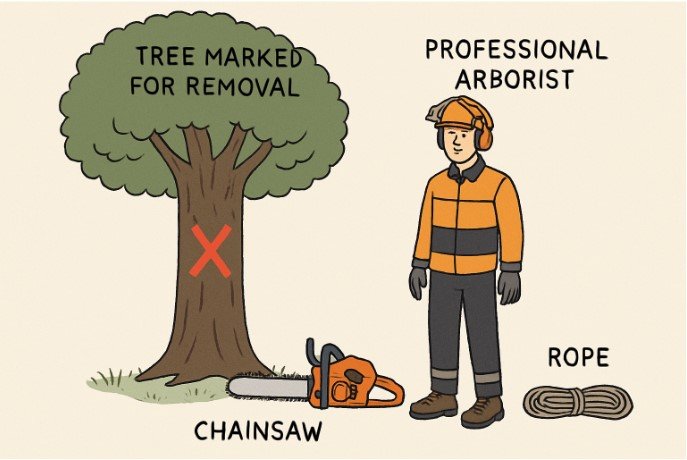Hiring a professional for tree removal ensures safety, efficiency, and long-term landscape health. Experts assess tree condition, handle specialized equipment, and manage risks that could harm property or nearby vegetation. They also provide cleanup and disposal, leaving your yard ready for new growth. With trained guidance, homeowners avoid costly mistakes and protect their surroundings. Whether addressing storm damage, diseased trees, or preventative care, working with a pro delivers peace of mind while preserving the beauty and safety of your outdoor space.
Why Tree Removal Matters: Safety, Health, and Beyond
Tree removal plays a crucial role in safeguarding properties and communities. Whether you’re a homeowner concerned about an aging oak threatening your home, or a business owner required to keep parking areas safe, there are times when tree removal is not just elective—it’s essential. Dead, dying, or dangerously leaning trees can fall unexpectedly, potentially resulting in severe property damage or injury. According to the Centers for Disease Control and Prevention (CDC), tree-related accidents account for significant injuries, especially following major storms or in high-risk settings.
Beyond immediate safety, removing hazardous or diseased trees helps maintain the long-term health of your landscape and even nearby ecosystems. Trees affected by invasive pests can quickly compromise otherwise healthy stands, so timely action supports community well-being. When a tree’s removal also requires cleanup and post-service care, professional services such as debris removal Fleming Island FL, ensure the process is thorough and efficient. Choosing expert assistance also reduces the risk of property damage. Your outdoor spaces remain safe, balanced, and visually appealing.
Recognizing When It’s Time to Remove a Tree
Deciding when a tree needs to be removed can be challenging, particularly if you’re emotionally attached to the landscape. However, several red flags indicate that action may be necessary. Signs include extensive decay, dead or brittle branches, heavily leaning trunks, or a noticeable decline in foliage density. Seasonal damage from storms or repeated disease outbreaks can accelerate a tree’s decline, making removal urgent to prevent accidents or damage to other plants.
While diligent homeowners may spot some issues, others require a professional arborist with expertise in tree health and structural stability. The Arbor Day Foundation’s tree health guidelines offer additional insights into diagnosing and understanding common tree pests and diseases. It’s always safer to consult a trained eye when in doubt to ensure the most informed decision.
What to Expect from a Professional Tree Removal Service
Working with a certified removal company ensures the job is handled immediately with safety, efficiency, and legal compliance. Most reputable services begin with a site inspection and consultation, followed by assistance in securing any required permits. On removal day, crews bring specialized equipment like chainsaws, cranes, and chippers to efficiently and safely bring down the targeted tree. Cleanup and debris haul-away are typically included, leaving your property restored and hazard-free.
Experienced tree removal teams adhere to strict safety protocols, protecting not only homes but also utility lines, fences, and neighboring properties. This professional approach minimizes risk and offers peace of mind you won’t find with DIY solutions.
Key Questions to Ask Before Hiring a Pro
Quality tree removal begins long before the first cut. Be sure to ask potential providers about their certifications, insurance coverage, and local licensing, as these guarantee industry competence and protection for all parties. Request written estimates and contracts that clearly outline the scope of work, timeline, and pricing. Clear communication ensures you understand every step, from site prep to post-removal care, and prevents unwelcome surprises. Check for references or online reviews to verify reliability and customer satisfaction.
Comparing DIY vs. Professional Tree Removal
While some homeowners may feel tempted to tackle tree removal themselves, the risks far outweigh the rewards. Amateur attempts are frequently linked to property damage, personal injury, and even fatalities—untrained individuals are many times more likely to be involved in accidents during removal. News reports regularly recount stories where failed DIY projects lead to unexpected tragedies or costly repairs.
Case studies from professional arborists highlight instances where their expertise prevented catastrophic outcomes, such as trees falling onto houses or tangling with power lines. Industry statistics confirm that working with trained crews dramatically reduces the likelihood of accidents, supporting a strong case for investing in specialized help.
Potential Pitfalls: What Can Go Wrong Without a Pro
Improper tree removal methods can unleash a cascade of problems. Structures, fences, vehicles, and even underground utilities are at risk if a tree falls unexpectedly or roots are removed carelessly. Inexperienced removals often damage healthy surrounding trees or compact the soil, leading to lasting landscape issues. In turn, costs for repairing this damage often far exceed the initial savings attempted by going solo. Overlooked stumps, poorly handled debris, and regrowth from incomplete root removal can disrupt your yard for years.
Improper techniques can also negatively affect soil quality, lead to erosion, and reduce biodiversity, impacting the health and sustainability of your landscape over time. The EPA’s guide on landscaping and climate change provides valuable information for a comprehensive look at safe property practices.
Preparing Your Property for Tree Removal
Preparation is key to a smooth experience. Homeowners should provide clear access by removing vehicles, patio furniture, and valuables from the work area, and notify neighbors of possible noise or temporary disruptions. Special care is needed in tight spaces or urban lots, where limited access and safety concerns are heightened. Working with companies experienced in urban tree removals is essential for such environments.
After the removal, post-care matters too. Clean up all debris, re-level disturbed ground, and consider soil conditioning to restore health and functionality to the immediate area. Watering, mulching, or seeding can accelerate the healing of your landscape.
After the Removal: What Happens Next?
Once the tree is down, the work isn’t over. Homeowners can choose between various disposal options: wood chips for landscaping, firewood, or green waste recycling, all of which minimize environmental impact. Most professional crews offer stump grinding or complete root removal, helping to prevent pest infestations and unwanted regrowth.
Removal also presents an ideal opportunity to replant or redesign your outdoor space. Selecting native species or shade-providing options can boost curb appeal and improve the local ecosystem—making your efforts today an investment in your property’s future.



